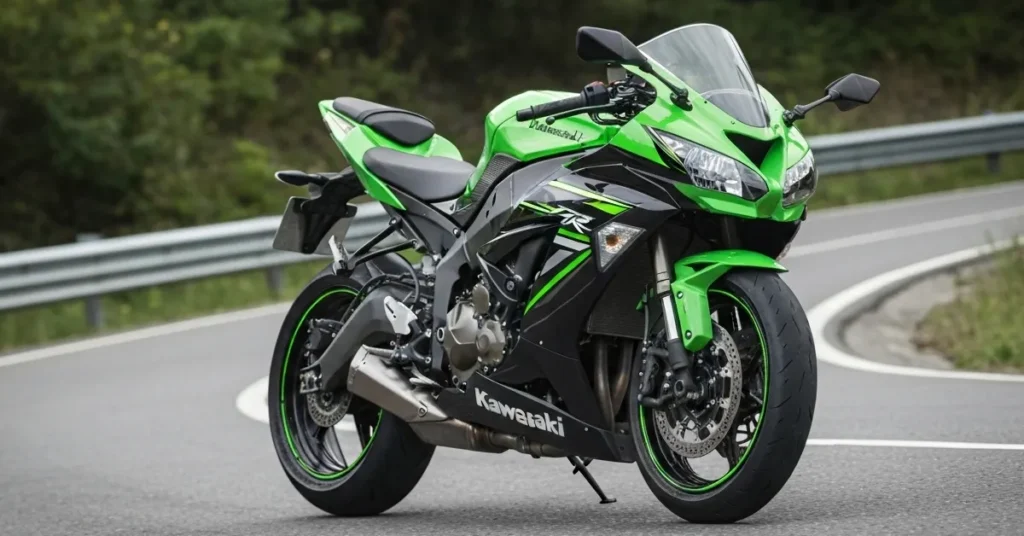Unveiled for the global market — including regions such as North America, Europe, India, and Southeast Asia — the new ZX-6R brings a blend of Japanese precision and modern sportbike technology. From aggressive new bodywork to smartphone connectivity, Kawasaki has clearly aimed to make this the most balanced ZX-6R ever built.
Design and Aerodynamics
The Ninja ZX-6R’s design takes clear inspiration from its big brother, the ZX-10R. The bike now wears sharper, layered fairings that not only look aggressive but also improve aerodynamic efficiency at high speeds. The inclusion of winglet-style inlets provides better front-end downforce, enhancing stability during cornering and braking.
Kawasaki’s designers have given it a purposeful stance, with sleek LED headlights, a compact tail section, and a short, blacked-out silencer that accentuates its supersport appeal. Every line serves a function — whether channeling airflow or reducing drag — giving riders a sense of connection between form and function. The bike looks equally impressive on a racetrack or parked outside a café.
Engine and Performance
At the heart of the 2026 ZX-6R lies its legendary 636 cc liquid-cooled inline-four engine. This slightly larger displacement than typical 600 cc rivals gives it a stronger low- and mid-range punch, without compromising the high-rev excitement that supersport enthusiasts love. The engine has been retuned for smoother throttle delivery, making it suitable for both city riding and aggressive track performance.
Performance figures place the ZX-6R among the best in its class. While official power numbers vary slightly by region, global models are expected to deliver around 128 hp at 13,000 rpm and 69 Nm of torque. Paired with a 6-speed gearbox and Kawasaki Quick Shifter (KQS) for clutch-less upshifts, it provides seamless acceleration that keeps the adrenaline flowing. The estimated top speed hovers around 250 km/h, depending on riding conditions.
The four riding modes — Sport, Road, Rain, and Rider (custom) — allow fine-tuned control over power delivery and traction settings, ensuring adaptability across diverse environments. The Rider mode lets you customize throttle response and traction sensitivity for a more personalized experience.
Ride and Handling
Handling has always been a hallmark of the ZX-6R, and the 2026 version refines it even further. The bike uses a pressed aluminum perimeter frame known for its rigidity and precise feedback. Suspension duties are managed by Showa’s SFF-BP (Separate Function Fork – Big Piston) at the front and a sporty rear mono-shock tuned for cornering stability.
The front end feels confident under braking and while turning, while the rear suspension offers enough compliance to absorb road imperfections. This balance makes the ZX-6R as comfortable carving through mountain roads as it is leaning into a racetrack apex. The ergonomics have been slightly revised with improved seat padding and optimized handlebar placement, making it comfortable enough for extended rides without losing its aggressive posture.
Technology and Features
Kawasaki has equipped the new Ninja ZX-6R with a host of advanced features that elevate the riding experience. The centerpiece is a 4.3-inch full-color TFT display that provides crisp visuals in any lighting condition. The display includes Bluetooth connectivity via Kawasaki’s Rideology app, allowing riders to access ride logs, maintenance data, and phone notifications directly on the screen.
Safety and control come courtesy of Kawasaki Intelligent ABS (KIBS), a system derived from Kawasaki’s superbike lineup. It monitors wheel speed, brake pressure, and lean angle to provide optimal braking performance even during aggressive cornering. Kawasaki Traction Control (KTRC) ensures maximum grip on varying surfaces, while dual power modes (Full and Low) allow riders to manage power output depending on riding conditions.
Braking and Safety
The braking setup consists of 310 mm dual semi-floating discs up front with radially mounted monobloc calipers and a 220 mm single rear disc. The combination delivers exceptional stopping power with excellent feel through the lever. The inclusion of KIBS further enhances braking performance, particularly during high-speed maneuvers or wet conditions.
Together with traction control and adjustable riding modes, these systems ensure that the ZX-6R offers a balance between raw performance and safety, making it suitable for riders who want both thrill and confidence in equal measure.
Fuel Efficiency and Practicality
While supersport bikes are not typically known for fuel economy, the 2026 Ninja ZX-6R has been fine-tuned for improved efficiency. Thanks to revised fuel mapping and improved air intake efficiency, riders can expect an average of 16–18 km/l, depending on riding style and conditions. The 17-liter fuel tank allows decent touring range for a sportbike in this segment.
Practical touches like the USB-compatible accessory socket, adjustable clutch and brake levers, and improved heat management make the bike surprisingly livable for everyday use — a rare quality in a high-performance supersport machine.
Global Pricing and Availability
The 2026 Ninja ZX-6R is positioned as a premium yet attainable middleweight supersport. Global pricing varies, but as of late 2025, estimated retail prices are:
- United States: Around $11,499 – $12,999 (depending on trim and accessories)
- Europe: €12,500 – €13,500
- India: ₹11 – ₹12 lakh (ex-showroom)
- Malaysia: RM62,000 – RM68,000
- UK: £10,999 – £11,999
Availability is expected in most markets by early 2026, with deliveries beginning in major Asian and European regions first.
Competition and Market Positioning
In the global middleweight sportbike arena, the 2026 Kawasaki Ninja ZX-6R competes directly with models like the Yamaha YZF-R6 (if available in limited markets), Honda CBR650R, and Triumph Daytona Moto2 765. Among these, the ZX-6R stands out for offering race-grade electronics, a proven chassis, and the unique 636 cc displacement advantage that gives it extra torque for real-world usability.
While many brands have pivoted away from pure supersports due to emissions and cost regulations, Kawasaki remains committed to the segment — a decision that has earned them respect from enthusiasts who crave focused performance machines.
Frequently Asked Questions (FAQs)
1. What is the engine capacity of the 2026 Kawasaki Ninja ZX-6R?
The bike is powered by a 636 cc liquid-cooled inline-four engine designed for strong low-end torque and thrilling top-end performance.
2. Does the ZX-6R come with electronic rider aids?
Yes. It features traction control (KTRC), multiple riding modes, dual power settings, Kawasaki Intelligent ABS (KIBS), and a quick shifter as standard equipment.
3. What is the top speed of the 2026 ZX-6R?
The estimated top speed is around 250 km/h, depending on regional specifications and riding conditions.
4. Is the ZX-6R comfortable for daily commuting?
Compared to older supersport bikes, the ZX-6R’s ergonomics are more relaxed, with improved seat padding and handlebar positioning, making it manageable for daily rides.
5. What are the color options available?
Kawasaki typically offers signature Lime Green, Metallic Black, and KRT Edition liveries, though color choices may vary by region.
6. How does it compare to the Yamaha R6 or Honda CBR650R?
While the Yamaha R6 is more track-focused and the Honda CBR650R leans toward touring comfort, the ZX-6R strikes a balance — offering both excitement and practicality with its 636 cc advantage and refined electronics.
Hi, my name is Hussain, the author behind Nirmalahss. I’ve always been passionate about exploring the latest in technology and automobiles, and this platform is my way of sharing that passion with others. Over the years, I’ve followed new gadgets, software trends, and the ever-changing auto industry closely, which has helped me develop a strong understanding of what truly matters to everyday users.

